Kuwait: Push for rights of Bidoon community after man attempts suicide

Kuwaiti lawmakers issued a draft law on Wednesday supporting basic human rights for members of the country's Bidoon minority after a 60-year-old man from the community attempted suicide through self-immolation.
The man, whose name remains unconfirmed, reportedly poured petrol on his body and set himself on fire for unclear reasons on Tuesday. He was taken to hospital to treat deep burns and remains in a critical condition.
Following the incident, five Kuwaiti MPs submitted a draft law demanding basic rights for the country’s Bidoon community.
Bidoon are regarded as foreign nationals or illegal immigrants in Kuwait, their name literally meaning “without,” implying that they are stateless or without nationality. The Kuwait state claims most of them moved to Kuwait from neighbouring countries and hid their nationalities to claim Kuwaiti citizenship.
MP Shuaib al-Muwaiziri blamed authorities for causing the Bidoon crisis, saying that the government should either prove that some Bidoons are citizens of foreign countries or grant them Kuwaiti citizenship, according to Kuwait Times.
Bidoon are also banned from obtaining birth and death certificates. Furthermore, they are denied identification documents, drastically reducing their access to job opportunities and social services while preventing them from traveling abroad.
Bidoon are also not allowed to be educated in Kuwaiti schools or universities.
Online support
Online, social media users expressed concern about the incident, noting that this is not the first time a Bidoon has attempted suicide.
Translation: This is not an isolated act and has nothing to do with the context of the life of only one Bidoon person. This has been a terrifying method of protest for three years. This level of defeat, depression, and helplessness has caused people not to go down to the streets but rise to the sky.
Translation: Different generations of Bidoon have used all means of suicide, from a noose wrapped around the neck of a child to an elderly Bidoon man setting himself on fire. The civil injustice that the Bidoon are enduring has produced depressed classes suffering from a state of great despair, and there is no way to escape but death.
The incident comes days after a 12-year-old Bidoon flower seller died after he was run over by a car while working in Kuwait City.
Jarrah Ayed al-Shammari was reportedly rushed to the hospital but was declared dead upon arrival.
One doctor, Maitham Hussain, happened to be at the site of the accident and had attempted to resuscitate Shammari, with the help of a woman, before he was taken to hospital.
He took to Twitter to talk about the experience, writing: “How long do the Bidoon suffer in the country of humanity? A child under the age of 12 died trying to make a living."
Suicide attempts within the Bidoon community have been on the rise recently as a form of protest against their treatment by authorities.
In February, 12-year-old Ali Khaled from the Sulaibiya region committed suicide by hanging himself in his room. The exact reasons behind his suicide are not yet clear.
Last year, Talal al-Khulaifi, 27, attempted to kill himself by self-immolation in protest against living conditions also in Sulaibiya. He survived but suffered severe burns.
Both incidents garnered widespread attention from social media users, who expressed their sympathy and called for immediate action to resolve the issues facing the Bidoon community.
According to Human Rights Watch, the Bidoon community is made up of around 88,000 to 106,000 stateless people.
Middle East Eye propose une couverture et une analyse indépendantes et incomparables du Moyen-Orient, de l’Afrique du Nord et d’autres régions du monde. Pour en savoir plus sur la reprise de ce contenu et les frais qui s’appliquent, veuillez remplir ce formulaire [en anglais]. Pour en savoir plus sur MEE, cliquez ici [en anglais].




